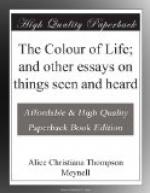If death is the privacy of the woods, it is the more conspicuously secret because it is their only privacy. You may watch or may surprise everything else. The nest is retired, not hidden. The chase goes on everywhere. It is wonderful how the perpetual chase seems to cause no perpetual fear. The songs are all audible. Life is undefended, careless, nimble and noisy.
It is a happy thing that minor artists have ceased, or almost ceased, to paint dead birds. Time was when they did it continually in that British School of water-colour art, stippled, of which surrounding nations, it was agreed, were envious. They must have killed their bird to paint him, for he is not to be caught dead. A bird is more easily caught alive than dead.
A poet, on the contrary, is easily—too easily—caught dead. Minor artists now seldom stipple the bird on its back, but a good sculptor and a University together modelled their Shelley on his back, unessentially drowned; and everybody may read about the sick mind of Dante Rossetti.
CLOUD
During a part of the year London does not see the clouds. Not to see the clear sky might seem her chief loss, but that is shared by the rest of England, and is, besides, but a slight privation. Not to see the clear sky is, elsewhere, to see the cloud. But not so in London. You may go for a week or two at a time, even though you hold your head up as you walk, and even though you have windows that really open, and yet you shall see no cloud, or but a single edge, the fragment of a form.
Guillotine windows never wholly open, but are filled with a doubled glass towards the sky when you open them towards the street. They are, therefore, a sure sign that for all the years when no other windows were used in London, nobody there cared much for the sky, or even knew so much as whether there were a sky.




